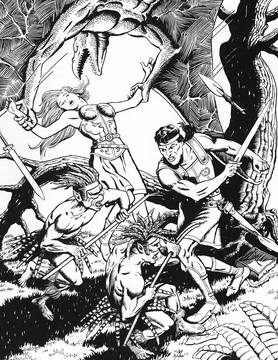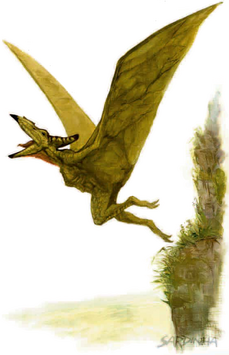Pterafolk (pronounced: /ˈtɛərɛfoʊlk/ TAIR-eh-folk[2]), also called "pteramen"[6] or "ptera-men",[5] were a race of shape-shifting pteranodon-like humanoids nearly unique to the jungles of Chult.[8]
Description[]
At first glance, pterafolk in their natural forms looked like tail-less lizardfolk or saurials, but they were much taller and leaner and had elongated cranial crests like pteranodons. They had smooth, fine scales, much like those of a snake, that ranged in color from forest-green to light shades of tan. Their arms and legs were thin and long, and their hands and feet bore sharp claws.[5][6][3][8]
Pterafolk did not wear clothing, except for belts and bandoliers for carrying small items.[7]
Personality[]
While not all lizardfolk were evil, it was generally agreed that pterafolk were cruel and vicious as a rule.[5][6] They were highly untrusting of anyone outside their own race.[10] They had an innate predilection towards violent behavior, but those raised in other societies sometimes had the capacity to overcome this tendency and take on alignments beyond evil.[7]
Pterafolk liked to collect things valued by the communities near where they lived.[5]
Abilities[]

Batiri and pteramen attack jungle adventurers.
Similar to how a yuan-ti could change its form at will into a snake, the pterafolk could "unfurl" a pair of eight-foot-long, leathery, webbed wings for flying or even take the form of a small pteranodon. They tended to only use such forms when they wanted to fly.[5][6][3]
Combat[]
Pterafolk rarely strategized, but they had certain tactics they used regularly in combat. They used dive-bombing tactics, dropping from altitudes of 100 feet (30 meters) or more to swoop down on their foes and strike with their rear claws, toothed beak, or barbed spears. They preferred circling their opponents and diving upon them in turn such that there would be a constant stream of diving attacks from all directions.[5][6][3]
Some clans cared little for training and relied only on instinct in battle. Others had a form of organized training that produced fighters, barbarians, or rangers.[7] If they wore armor or used weapons—often barbed spears[5][6][3]— they were custom-made to not interfere with flight.[7]
Society[]
Pterafolk were sometimes called the "Hidden Folk" along with ophidians, because they were not well-known and preferred to stay that way.[11] While they were extremely rare outside the Chultan Peninsula, in 1372 DR they made up 4% of the population of Chult.[12]
Their culture was one where the strong trampled on the weak, and the needs of an individual outweighed the needs of the group.[8] Betrayal and infighting were common occurrences.[10]
Pterafolk lived either in large tribes or in small bands of between ten and thirty individuals. The smaller groups were disorganized and generally controlled by which ever pterafolk individual was strongest or loudest.[5][6]
Larger tribes had established communities with cultures similar to those of other races living around them.[5][6] Tribes were subdivided into clans of related individuals.[10] Strangely, these larger tribes were often ruled by a spirit naga, who functioned as chieftain with absolute power and responded to the tribe's requests and acted as a judge over their disputes.[10]
Pterafolk lived in grass huts built high above the jungle canopy. Each hut housed one to four persons.[5][6]
Pterafolk were enemies of the Tabaxi tribe of humans and the Batiri goblin tribe.[5][6][3] Ironically, pterafolk were sometimes preyed upon by actual pteranodons.[5][9]
Magic[]
Pterafolk distrusted magic, so spellcasters were very rare among them, and they would usually destroy any magical items they found as spoils. If the tribe was overseen by a spirit naga, it might train up acolytes who could cast divine magic.[7]
Language[]
Pterafolk, like most reptilian creatures, spoke Draconic.[3]
Religion[]
After the breakup of the World Serpent, most pterafolk took to worshiping Shekinester, the goddess of spirit nagas. They held that the primary forces of nature were chaos and destruction. They followed their deity by bringing about more destruction into the world.[7]
Biology[]

A pterafolk takes flight.
Pterafolk ate both meat and vegetables. Their favorite meats were from brontotheres and hornless rhinoceros—massive prehistoric mammals still roaming in the jungles of Chult—and axebeaks—mammoth flightless birds. They also consumed jungle fruits, roots, bark, and flowers.[5][9]
Pterafolk mated for life.[5][9] Females laid eggs high on mountain peaks and both parents guarded the eggs.[10] When the young reached adulthood, they would leave the tribe and form smaller bands until they could establish territory or a tribe of their own.[5][9]
It was exceptionally rare for a pterafolk individual to die of old age; death in battle was expected.[10]
History[]
Sages and scholars of Faerûn believed that lizardfolk evolved from pterafolk. Rumors among adventurers claimed that pterafolk were the result of magical experiments on pteranodons.[5][6]
In fact, neither tale was true; pterafolk were one of the many creations of the sarrukh of Mhairshaulk[13] and were bred from lizardfolk.[8] The pterafolk gave the sarrukh armies more power, owing to their flight and viciousness, but they were also more difficult to control.[8]
After the fall of Mhairshaulk, many of the sarrukh's enemies attempted to hunt down and destroy the pterafolk.[10]
During the Time of Troubles in 1358 DR, the god Kossuth led a war against the pterafolk after appearing below the Peaks of Flame and choosing a firenewt named Chassan as his avatar.[14]
While they usually kept to themselves, in 1363 DR, Kaverin Ebonhand had managed to convince several dozen of them to fight with him in his assault on the holy city of Mezro. They dropped rocks and explosive items upon the city from the air. When Kaverin was slain by the famous Harper Artus Cimber, however, the pterafolk abandoned the fight.[5][9][3]
Appendix[]
Appearances[]
Adventures
Novels & Short Stories
The Mage in the Iron Mask
Video Games
Board Games
Organized Play & Licensed Adventures
Connections[]
References[]
- ↑ James Lowder (November 1992). The Ring of Winter. (TSR, Inc), chap. 15, p. 269. ISBN 978-1560763307.
- ↑ 2.0 2.1 2.2 Christopher Perkins, Will Doyle, Steve Winter (September 19, 2017). Tomb of Annihilation. Edited by Michele Carter, Scott Fitzgerald Gray. (Wizards of the Coast), p. 229. ISBN 978-0-7869-6610-3.
- ↑ 3.0 3.1 3.2 3.3 3.4 3.5 3.6 3.7 3.8 3.9 James Wyatt, Rob Heinsoo (February 2001). Monster Compendium: Monsters of Faerûn. Edited by Duane Maxwell. (Wizards of the Coast), p. 74. ISBN 0-7869-1832-2.
- ↑ 4.0 4.1 Richard Baker and James Wyatt (2004-03-13). Monster Update (Zipped PDF). Web Enhancement for Player's Guide to Faerûn. Wizards of the Coast. pp. 5–6. Archived from the original on 2016-11-01. Retrieved on 2018-09-10.
- ↑ 5.00 5.01 5.02 5.03 5.04 5.05 5.06 5.07 5.08 5.09 5.10 5.11 5.12 5.13 5.14 5.15 5.16 5.17 5.18 5.19 James Lowder, Jean Rabe (1993). The Jungles of Chult (Monstrous Compendium). (TSR, Inc). ISBN 1-5607-6605-0.
- ↑ 6.00 6.01 6.02 6.03 6.04 6.05 6.06 6.07 6.08 6.09 6.10 6.11 6.12 Dale Donovan (July 1998). Villains' Lorebook. (TSR, Inc), p. 80. ISBN 0-7869-1236-7.
- ↑ 7.0 7.1 7.2 7.3 7.4 7.5 7.6 Ed Greenwood, Eric L. Boyd, Darrin Drader (July 2004). Serpent Kingdoms. (Wizards of the Coast), p. 52. ISBN 0-7869-3277-5.
- ↑ 8.0 8.1 8.2 8.3 8.4 8.5 Ed Greenwood, Eric L. Boyd, Darrin Drader (July 2004). Serpent Kingdoms. (Wizards of the Coast), p. 50. ISBN 0-7869-3277-5.
- ↑ 9.0 9.1 9.2 9.3 9.4 9.5 Dale Donovan (July 1998). Villains' Lorebook. (TSR, Inc), p. 97. ISBN 0-7869-1236-7.
- ↑ 10.0 10.1 10.2 10.3 10.4 10.5 10.6 Ed Greenwood, Eric L. Boyd, Darrin Drader (July 2004). Serpent Kingdoms. (Wizards of the Coast), p. 51. ISBN 0-7869-3277-5.
- ↑ Ed Greenwood, Eric L. Boyd, Darrin Drader (July 2004). Serpent Kingdoms. (Wizards of the Coast), p. 49. ISBN 0-7869-3277-5.
- ↑ Ed Greenwood, Sean K. Reynolds, Skip Williams, Rob Heinsoo (June 2001). Forgotten Realms Campaign Setting 3rd edition. (Wizards of the Coast), p. 103. ISBN 0-7869-1836-5.
- ↑ Brian R. James, Ed Greenwood (September 2007). The Grand History of the Realms. Edited by Kim Mohan, Penny Williams. (Wizards of the Coast), p. 5. ISBN 978-0-7869-4731-7.
- ↑ Ed Greenwood, Eric L. Boyd, Darrin Drader (July 2004). Serpent Kingdoms. (Wizards of the Coast), p. 37. ISBN 0-7869-3277-5.
